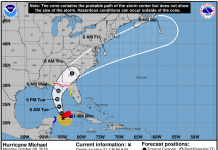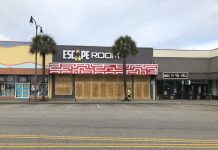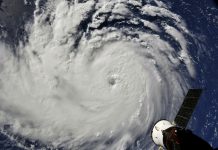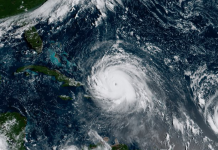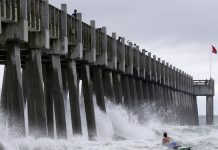NEWPORT NEWS, Va. (AP) — When Newport News Fire Department Battalion Chief Jim Gower arrived in a small city in east Texas to assist with Harvey relief, the floodwaters already had receded. But what he saw was people who have no homes to go back to, no cars, no jobs.
“It’s just sad to see people struggling to get back on their feet,” Gower told the Daily Press last week after returning from his work in Nacogdoches, Texas, with the Hampton Roads Incident Management Team.
Gower is one of dozens of Hampton Roads-area first responders, medical professionals and others who have traveled in recent weeks to assist with relief after hurricanes Harvey and Irma. The record-breaking back-to-back storms caused massive devastation in Texas, the Caribbean, Florida, Georgia and South Carolina.
“The devastation was amazing,” he said. “I don’t think a lot of these communities have ever seen anything like this.”
Harvey
Harvey first made landfall in Rockport, Texas, on Aug. 25 as a Category 4 hurricane. It spun east across the Texas Gulf Coast before stalling as a tropical storm and dumping historic rainfall onto Houston and southeast Texas.
At least 70 people drowned in floods, got crushed by trees and died during power outages, according to The Associated Press. The storm caused about $198.63 billion in damage to nine Texas counties, Ball State’s Center for Business and Economic Research estimates.
Brandon Curry, a senior medic-firefighter with the Hampton Division of Fire and Rescue, was among the first local group to respond with the Virginia Beach-based Virginia Task Force II Urban Search and Rescue Team.
Fourteen members of the highly skilled Federal Emergency Management Agency team deployed with a water rescue package on Aug. 27. They drove straight through until they encountered flooded roadways in Woodlands, Texas, 50 miles short of their destination. The team stayed in a hotel conference room for the night and continued on to Katy the next morning. They had to take back roads because the interstate was flooded, Curry said.
During just the first day in Katy, the team rescued nearly 500 people from apartment complexes where floodwaters had risen in some areas to 5 feet.

FILE – In this Tuesday, Aug. 29, 2017, file photo, water from Addicks Reservoir flows into neighborhoods as floodwaters from Harvey rise in Houston. Allstate expects $593 million in insurance losses for August due to Hurricane Harvey. That marks a spike from $181 million in July. The estimates do not include Hurricane Irma, which made landfall in September. Photo: AP Photo/David J. Phillip, File.
“We started going to work right off the bat,” Curry said. “We were there all day working … we were hustling.”
Evacuees loaded into the team’s six rescue boats, bringing with them a few belongings. The crews had watch for alligators and snakes, as well as downed power lines. The electricity was still on, an additional hazard Curry said he wasn’t expecting.
“It was really eerie being down there,” he said. “You’re kind of watching everywhere you move.”
Curry has helped with multiple previous water rescues, including after hurricanes Matthew and Sandy. But he said in none of the other missions had he seen so many people who needed help than after Harvey. The devastation was widespread in urban areas, and the victims weren’t prepared for it.
“They just didn’t think the water would get that high,” he said.
The team continued water rescues through the end of the week and was released to go back home Sept. 4.
Meanwhile, Newport News’ Gower arrived on Sept. 3 in Nacogdoches, about 170 miles northeast of Katy. He was one of 27 members to be deployed with the Hampton Roads and National Capital Region Incident Management teams. Their mission was to provide shelter support.
Gower worked as the communications unit leader, coordinating radio assignments and technology needs. Newport News Battalion Chief Matthew Haraburda was assigned to logistics, maintaining equipment and supplies.
The team assisted with managing three shelters during the five-day trip. They left when the community was able to reduce the shelters down to one.
Gower said he heard during briefings with state officials about truckloads of donations coming in. He said the biggest challenge with that is there’s no one to distribute many of the items and no place for them to go. He urged local residents to be mindful of that and consider donating money to reputable charities instead of items.
“They didn’t have the logistics to handle all those donations,” he said. “People don’t need truckloads of old clothes; they need basic necessities and funds … to help them get back on their feet.”
Irma
By the time Hurricane Irma began to travel north of Puerto Rico, Virginia Task Force II Urban Search and Rescue Team’s second contingency already was in San Juan.
Irma grew into a Category 5 hurricane Sept. 5 — the same day the team of 45 arrived. That day, winds hit 185 miles per hour. The storm barreled through the Caribbean before pummeling the Florida Keys and Marco Island. The storm then weakened to a Category 4 and Category 3. Fifteen more members joined the task force team three days later.
Meanwhile, the Virginia 1 Disaster Medical Assistance Team sent about 35 people from Hampton Roads, Williamsburg and Richmond down to Orlando Sept. 8.
The team is staffed with emergency room physicians, emergency room nurses, and paramedics from fire and EMS departments, according to spokesman David Long.
Irma made one last punch as a hurricane in Orlando before weakening to a tropical storm Sept. 10. It left about 6.5 million homes and businesses without power and 200,000 people in shelters, according to the Orlando Sentinel.
The tropical storm continued north, causing more flooding in northeast Florida, Georgia and South Carolina.
Between Harvey and Irma, the damage could reach $300 billion. As of Sept. 15, Irma’s death toll climbed to more than 70 people, and 1.9 million homes and businesses were without power, including 64 nursing homes.

Thirty-eight of the deaths were in the Caribbean where Task Force II was sent to work. The members spent a bulk of their time divvied up between the islands of St. Thomas and St. John, where they performed search and rescue missions in more than 2,000 structures. The majority of the team returned to Virginia Beach on Sept. 16; four members remained in San Juan.
“They’re trying to make sure that in all those areas where there’s basically rubble there that there aren’t people down there who’re stranded,” Art Kohn, a spokesman for the Virginia Beach Fire Department, said late last week.
In all, Virginia Task Force II can send three separate contingencies to help out in disasters. The first helped in Hurricane Harvey. The third contingency hasn’t been sent anywhere yet, he said.
Newport News firefighter Brian Sanzo has spent most of his time on St. Thomas, where he said damage looked like it came from a tornado, not a hurricane.
“We’re used to huge storm surges, and we’re not seeing a lot of that. It’s mostly wind damage, so that was a little different in itself,” he said by phone in San Juan.
They’ve been depending on helicopters, boats and ferries to get from one island to another. As far as cleanup goes, the island’s made a lot of progress, he said.
“I gotta say, the folks in St. Thomas are very resilient people, very friendly,” he said. “They pretty much had best attitude I’ve ever seen of anyone.”
Between the rough terrain and high heat and humidity, it hasn’t been easy.
“That’s what we do, and the guys did a good job as far as accomplishing it,” he said.



